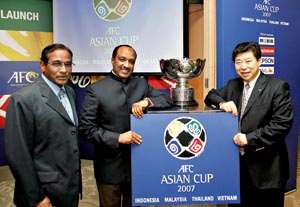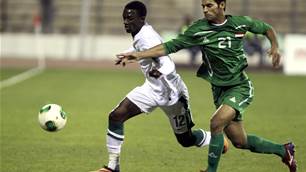Are the Socceroos set to write another fine chapter in Australia’s sporting history?
When Australia joined the Asian Football Confederation (AFC) on 1 January 2006, many agreed the most valued reward would be a fairer qualification path to the World Cup. Having finally turned our backs on the ruthless two-leg play-off system, Australians can look forward to qualification through Asia. Beginning now though, the move represents so much more... we are on the path to the 2007 Asian Cup.
Eyes on the prize
Before joining the AFC, Socceroo supporters had a mere handful of meaningful international fixtures every four years. Australia’s inclusion in AFC tournaments however, presents many more opportunities to support the Socceroos in full competitive internationals. Can we dare to dream that Australia will earn AFC Cup glory on its very first attempt?
The AFC is the world’s largest football association, with 46 member nations – whose populations equate to more than half the world’s population. Geographically, AFC nations cover half the globe. As the AFC’s marquee competition, the Asian Cup comes with a rich history, millions of viewers, some of the world’s most entertaining football and the football world’s respect. The ambition to hold it aloft is what unites nations as distant and diverse as Saudi Arabia, Uzbekistan, Japan and now Australia.
Rich history
The first Asian Cup tournament was devised by the 12 members of the newly formed AFC in 1954 to help strengthen football in the region. Eventually held in Hong Kong in 1956 (50 years ago and in the same year as the Melbourne Olympic Games), the first tournament featured seven of the AFC’s member nations. Since then, the tournament has been held every four years with a range of competing nations, hosts and victors.
Korea and Israel dominated the first three Asian Cups, with Korea beating Israel into second place in the first two tournaments. As hosts, Israel came back to win in 1964 – less than 10 years later they left the AFC to become a member country of UEFA.
The following three Asian Cup tournaments saw the emergence of Iran, who, aided by hosting the tournament in 1968 and 1976, won a record three consecutive trophies. Despite a total of nine World Cup appearances between them since, neither Korea nor Iran have managed to win another Asian Cup.
 The opponents
The opponents
Kuwait has also enjoyed home advantage. As hosts in 1980, Kuwait celebrated their first Asian Cup victory, beating off Korea Republic 3-0 with a commanding performance in the final. 1984 signalled the start of a new era, as Saudi Arabia and Blue Samurai (Japan) dominance came to the fore. In every Asian Cup tournament since, only Saudi Arabia and Japan have been crowned champions – Japan has been victorious in the last two tournaments (held in Lebanon in 2000 and China in 2004). Japan’s first Asian Cup win came as hosts in 1992.
The most recent Asian Cup – 2004 – was held in China where the hosts played their arch East Asian rivals Japan in the final. Astonishingly, some 300 million Chinese and close to 40 per cent of the Japanese viewing audience tuned in to watch a dramatic 3-1 victory for Japan. A staggering 450 million people watched the final. Comparatively only 24 million people – a fraction of the world’s population – saw Greece win Euro 2004.
The Asian Cup is watched by viewers in 120 countries and is easily the single-biggest sporting event in Asia. In comparison, the 2005 AFL Grand Final in 2005 reached an audience of 3.4 million, while the third Rugby League State of Origin match this year attracted about 2.4 million.
How it works
To accommodate the 2008 Beijing Olympics, the AFC are breaking with tradition and holding the next Asian Cup in 2007. In an unprecedented move, four countries have been given hosting duties: Indonesia, Malaysia, Thailand and Vietnam.
Though the host nations are faced with some logistical difficulties, football fans from Asia and across the globe can look forward to another football feast.
Sixteen teams qualify for the Asian Cup, divided into four groups of four. As automatic qualifiers, the hosts together have already occupied a quarter of the available slots. The current qualification rounds will produce the other 12 competitors, with the top two teams in each of the six groups qualifying for the finals.
In Kuwait and Bahrain, Australia has just two group opponents following Lebanon’s withdrawal from Group D.
Beyond 2007, Australia’s future in the Asian Cup looks bright. With one eye on proving we can host major football tournaments, there is an excellent chance that Australia will host an Asian Cup before long. So, in addition to years of quality matches, we can look forward to welcoming the stars of Asia – players like Bayern Munich and Iran’s Ali Karimi, Celtic and Japan’s Shunsuke Nakamura and Manchester United and Korea’s Park Ji-Sung – to Australia.

Eyes on the prize
Before joining the AFC, Socceroo supporters had a mere handful of meaningful international fixtures every four years. Australia’s inclusion in AFC tournaments however, presents many more opportunities to support the Socceroos in full competitive internationals. Can we dare to dream that Australia will earn AFC Cup glory on its very first attempt?
The AFC is the world’s largest football association, with 46 member nations – whose populations equate to more than half the world’s population. Geographically, AFC nations cover half the globe. As the AFC’s marquee competition, the Asian Cup comes with a rich history, millions of viewers, some of the world’s most entertaining football and the football world’s respect. The ambition to hold it aloft is what unites nations as distant and diverse as Saudi Arabia, Uzbekistan, Japan and now Australia.
Rich history
The first Asian Cup tournament was devised by the 12 members of the newly formed AFC in 1954 to help strengthen football in the region. Eventually held in Hong Kong in 1956 (50 years ago and in the same year as the Melbourne Olympic Games), the first tournament featured seven of the AFC’s member nations. Since then, the tournament has been held every four years with a range of competing nations, hosts and victors.
Korea and Israel dominated the first three Asian Cups, with Korea beating Israel into second place in the first two tournaments. As hosts, Israel came back to win in 1964 – less than 10 years later they left the AFC to become a member country of UEFA.
The following three Asian Cup tournaments saw the emergence of Iran, who, aided by hosting the tournament in 1968 and 1976, won a record three consecutive trophies. Despite a total of nine World Cup appearances between them since, neither Korea nor Iran have managed to win another Asian Cup.
 The opponents
The opponentsKuwait has also enjoyed home advantage. As hosts in 1980, Kuwait celebrated their first Asian Cup victory, beating off Korea Republic 3-0 with a commanding performance in the final. 1984 signalled the start of a new era, as Saudi Arabia and Blue Samurai (Japan) dominance came to the fore. In every Asian Cup tournament since, only Saudi Arabia and Japan have been crowned champions – Japan has been victorious in the last two tournaments (held in Lebanon in 2000 and China in 2004). Japan’s first Asian Cup win came as hosts in 1992.
The most recent Asian Cup – 2004 – was held in China where the hosts played their arch East Asian rivals Japan in the final. Astonishingly, some 300 million Chinese and close to 40 per cent of the Japanese viewing audience tuned in to watch a dramatic 3-1 victory for Japan. A staggering 450 million people watched the final. Comparatively only 24 million people – a fraction of the world’s population – saw Greece win Euro 2004.
The Asian Cup is watched by viewers in 120 countries and is easily the single-biggest sporting event in Asia. In comparison, the 2005 AFL Grand Final in 2005 reached an audience of 3.4 million, while the third Rugby League State of Origin match this year attracted about 2.4 million.
How it works
To accommodate the 2008 Beijing Olympics, the AFC are breaking with tradition and holding the next Asian Cup in 2007. In an unprecedented move, four countries have been given hosting duties: Indonesia, Malaysia, Thailand and Vietnam.
Though the host nations are faced with some logistical difficulties, football fans from Asia and across the globe can look forward to another football feast.
Sixteen teams qualify for the Asian Cup, divided into four groups of four. As automatic qualifiers, the hosts together have already occupied a quarter of the available slots. The current qualification rounds will produce the other 12 competitors, with the top two teams in each of the six groups qualifying for the finals.
In Kuwait and Bahrain, Australia has just two group opponents following Lebanon’s withdrawal from Group D.
Beyond 2007, Australia’s future in the Asian Cup looks bright. With one eye on proving we can host major football tournaments, there is an excellent chance that Australia will host an Asian Cup before long. So, in addition to years of quality matches, we can look forward to welcoming the stars of Asia – players like Bayern Munich and Iran’s Ali Karimi, Celtic and Japan’s Shunsuke Nakamura and Manchester United and Korea’s Park Ji-Sung – to Australia.

Related Articles

Asian Cup Qualifying: Trio make it to Australia

Saudi Arabia, UAE firm for 2015 Asian Cup













